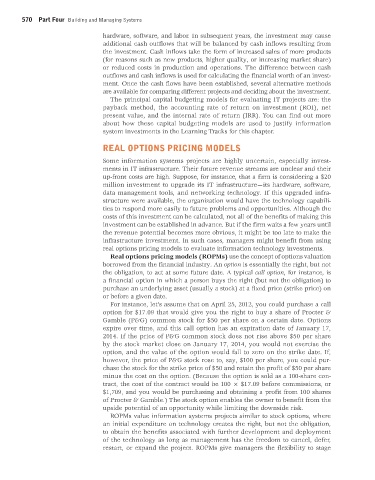Page 571 -
P. 571
570 Part Four Building and Managing Systems
hardware, software, and labor. In subsequent years, the investment may cause
additional cash outflows that will be balanced by cash inflows resulting from
the investment. Cash inflows take the form of increased sales of more products
(for reasons such as new products, higher quality, or increasing market share)
or reduced costs in production and operations. The difference between cash
outflows and cash inflows is used for calculating the financial worth of an invest-
ment. Once the cash flows have been established, several alternative methods
are available for comparing different projects and deciding about the investment.
The principal capital budgeting models for evaluating IT projects are: the
payback method, the accounting rate of return on investment (ROI), net
present value, and the internal rate of return (IRR). You can find out more
about how these capital budgeting models are used to justify information
system investments in the Learning Tracks for this chapter.
REAL OPTIONS PRICING MODELS
Some information systems projects are highly uncertain, especially invest-
ments in IT infrastructure. Their future revenue streams are unclear and their
up-front costs are high. Suppose, for instance, that a firm is considering a $20
million investment to upgrade its IT infrastructure—its hardware, software,
data management tools, and networking technology. If this upgraded infra-
structure were available, the organization would have the technology capabili-
ties to respond more easily to future problems and opportunities. Although the
costs of this investment can be calculated, not all of the benefits of making this
investment can be established in advance. But if the firm waits a few years until
the revenue potential becomes more obvious, it might be too late to make the
infrastructure investment. In such cases, managers might benefit from using
real options pricing models to evaluate information technology investments.
Real options pricing models (ROPMs) use the concept of options valuation
borrowed from the financial industry. An option is essentially the right, but not
the obligation, to act at some future date. A typical call option, for instance, is
a financial option in which a person buys the right (but not the obligation) to
purchase an underlying asset (usually a stock) at a fixed price (strike price) on
or before a given date.
For instance, let’s assume that on April 25, 2012, you could purchase a call
option for $17.09 that would give you the right to buy a share of Procter &
Gamble (P&G) common stock for $50 per share on a certain date. Options
expire over time, and this call option has an expiration date of January 17,
2014. If the price of P&G common stock does not rise above $50 per share
by the stock market close on January 17, 2014, you would not exercise the
option, and the value of the option would fall to zero on the strike date. If,
however, the price of P&G stock rose to, say, $100 per share, you could pur-
chase the stock for the strike price of $50 and retain the profit of $50 per share
minus the cost on the option. (Because the option is sold as a 100-share con-
tract, the cost of the contract would be 100 × $17.09 before commissions, or
$1,709, and you would be purchasing and obtaining a profit from 100 shares
of Procter & Gamble.) The stock option enables the owner to benefit from the
upside potential of an opportunity while limiting the downside risk.
ROPMs value information systems projects similar to stock options, where
an initial expenditure on technology creates the right, but not the obligation,
to obtain the benefits associated with further development and deployment
of the technology as long as management has the freedom to cancel, defer,
restart, or expand the project. ROPMs give managers the flexibility to stage
MIS_13_Ch_14_global.indd 570 1/17/2013 2:31:59 PM

